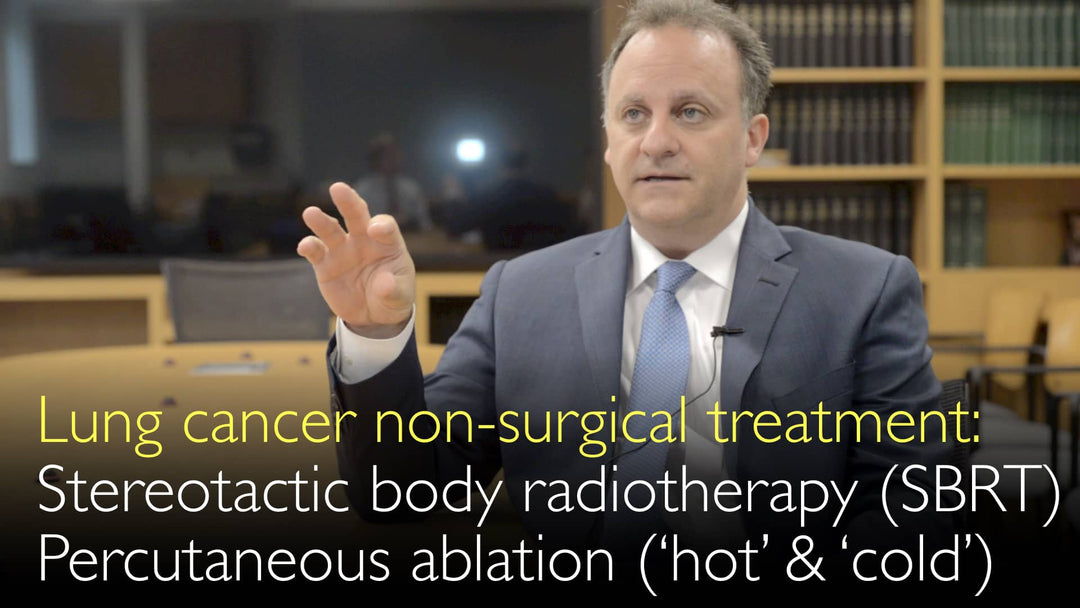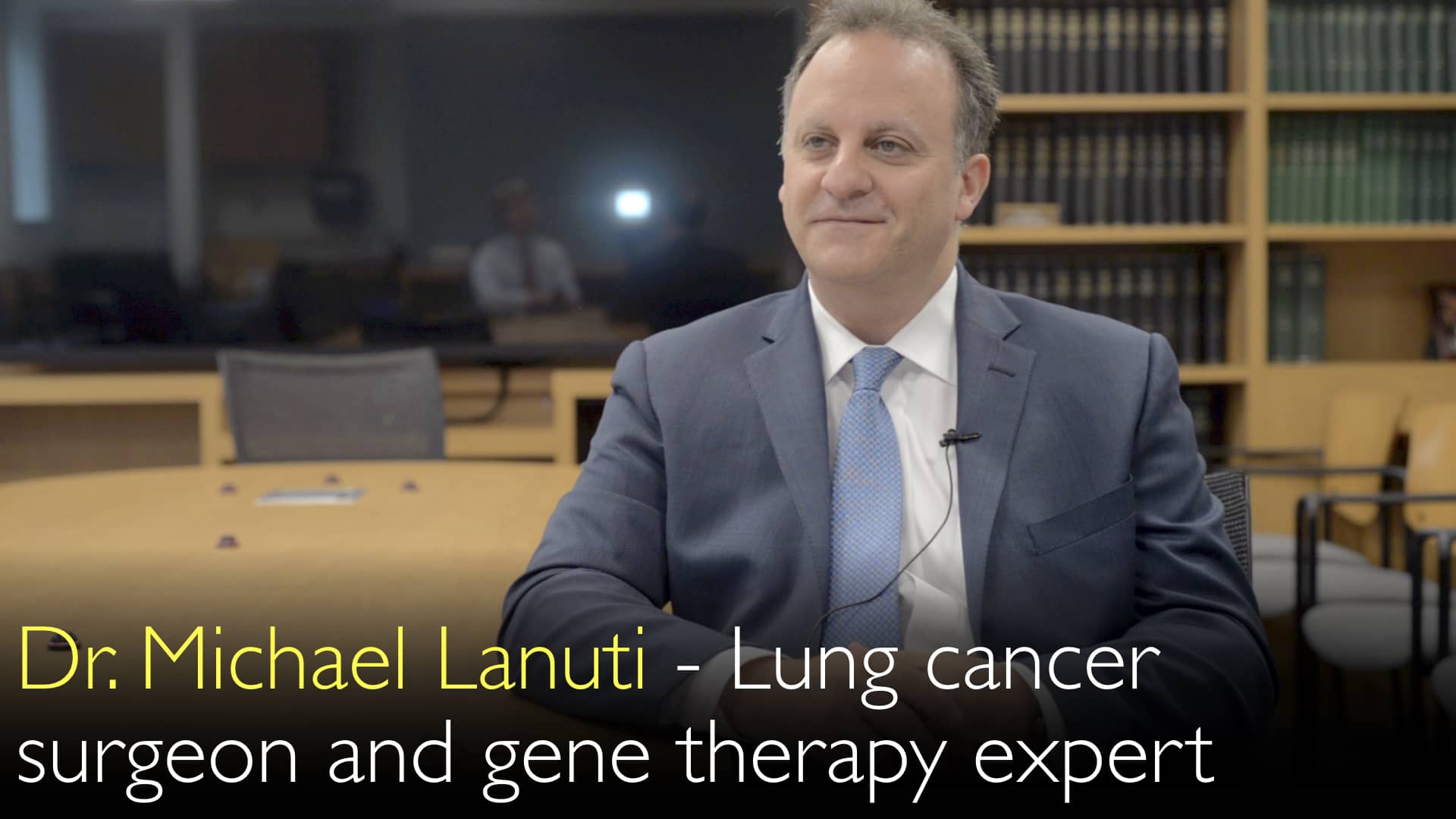Dr. Michael Lanuti, MD, en førende ekspert inden for thorakalkirurgi og lungekræftbehandling, forklarer, hvordan stereotaktisk stråleterapi (SBRT) og perkutane ablationsmetoder udgør effektive, ikke-kirurgiske alternativer for patienter med tidlig lungekræft, som ikke kan opereres på grund af alder, nedsat lungefunktion eller andre sygdomme. Disse behandlinger opnår lokale kontrolrater på 85–90 %.
Avancerede ikke-kirurgiske behandlinger af tidlig lungekræft
Spring til afsnit
- SBRT-behandling af lungekræft
- Perkutan termisk ablation
- Radiofrekvens vs. kryoablation
- Ideel tumorstørrelse og placering
- Kirurgi forbliver guldstandarden
- Patientudvælgelseskriterier
- Behandlingssuccesrater
SBRT-behandling af lungekræft
Stereotaktisk stråleterapi (SBRT) er blevet en meget udbredt og effektiv behandling for ældre patienter med tidlig lungekræft. Ifølge dr. Michael Lanuti, MD, opnår SBRT fremragende lokale behandlingsresultater, typisk med en succesrate på 85–90%. Denne ikke-invasive teknik leverer højt fokuserede, intense stråledoser til tumoren, mens den minimerer eksponeringen af det omkringligrende raske lungevæv.
Metoden er særligt velegnet til patienter, der ikke kan gennemgå en operation på grund af nedsat lunge-hjerte-kapacitet eller andre alvorlige helbredsproblemer.
Perkutan termisk ablation
Perkutan termisk ablation udgør en anden effektiv lokal behandlingsmulighed for inoperable lungekræfttilfælde. Dr. Michael Lanuti, MD, beskriver metoderne som "varme eller kolde" behandlinger af lungekræft. Disse minimalt invasive procedurer indebærer indføring af en probe direkte i tumoren gennem huden under vejledning af CT-scanning eller ultralyd.
Teknologien bag termisk ablation udvikles og forbedres løbende, hvilket gør det muligt at behandle stadig større kræftknuder effektivt i én session og derved tilbyde et væsentligt alternativ for patienter, der ikke kan opereres.
Radiofrekvens vs. kryoablation
Valget mellem "varm" radiofrekvensablation og "kold" kryoablation afhænger i høj grad af tumorens placering. Dr. Michael Lanuti, MD, forklarer, at radiofrekvensablation (RFA) anvender varme til at ødelægge kræftceller og er velegnet til kræft på lungens yderste rand.
Kryoablation fryser derimod tumoren og foretrækkes, når læsionen ligger tæt på interkostalnerverne under ribbenene. Anvendelse af kryoterapi i disse følsomme områder resulterer i færre tilfælde af neuralgi eller nerveskader efter indgrebet og undgår smertefulde rygsyndromer.
Ideel tumorstørrelse og placering
Effektiviteten af perkutan ablation afhænger i høj grad af lungekræftens størrelse og placering. Ifølge dr. Lanuti er radiofrekvensablation mest effektiv ved kræftknuder på 3 centimeter eller derunder. Større tumorer har ofte højere fiaskorater med ablationsterapi.
Han bemærker dog, at mikrobølgeablationsprober til tider kan anvendes til effektivt at behandle større læsioner. Placeringen er lige så afgørende, da perifere tumorer generelt er mere tilgængelige og sikrere at behandle med disse lokale teknikker end centrale tumorer nær store luftveje eller blodkar.
Kirurgi forbliver guldstandarden
På trods af fremskridt inden for ikke-kirurgiske muligheder forbliver kirurgi stadig guldstandarden for lungekræftbehandling, når det er muligt. Dr. Michael Lanuti, MD, understreger, at kirurgisk fjernelse er førstevalg for at opnå helbredelse hos egnede patienter. Valget af ablation eller SBRT træffes kun, når kirurgi ikke er en mulighed.
Dr. Anton Titov, MD, og dr. Lanuti bekræfter, at hvis en patient er en god kandidat til operation med lave risici, anbefales kirurgi som den mest afgørende behandling.
Patientudvælgelseskriterier
Valget af den rette behandling kræver en omhyggelig vurdering af et multidisciplinært team. Disse behandlinger er primært for patienter, der er for ældre, har utilstrækkelig lungefunktion eller mangler lunge-hjerte-kapacitet til at gennemgå en større operation. Som dr. Lanuti påpeger, kan nogle patienter allerede have modtaget stråling nær kræftstedet, hvilket gør SBRT uegnet og ablation til et bedre alternativ.
Selv patienter, der er egnet til kirurgi, men vælger det fra, kan overvejes til disse lokale behandlinger, selvom kirurgi stadig anses for overlegen i forhold til helbredelsespotentiale.
Behandlingssuccesrater
Succesen af ikke-kirurgiske lokale behandlinger måles ved deres høje rater for lokal kontrol og kræftrespons. Dr. Michael Lanuti, MD, nævner imponerende lokale behandlingsresultater på 85–90% for stereotaktisk stråleterapi. Disse resultater gør SBRT og ablation til overbevisende muligheder for en specifik patientgruppe, der ellers ville have begrænsede kurative valg.
Teknikkerne tilbyder en engangsbehandling, der effektivt kan eliminere den primære kræft og give mulighed for langtidskontrol og forbedret livskvalitet for ikke-operative patienter.
Fuld transskription
Dr. Michael Lanuti, MD: Ikke-kirurgisk behandling af lungekræft omfatter stereotaktisk stråleterapi (SBRT) og perkutan ablation ("varm" og "kold"). Nogle lungekræftpatienter er for svage eller ældre til kirurgi. Her er ny gennembrudsbehandling for lungekræft relevant.
Lungekræft behandles med kirurgisk fjernelse, når det er muligt. Kirurgi kan udføres som åben operation eller minimalt invasivt. Men der findes også andre lokale behandlingsmuligheder. En er radiofrekvensablation af lungekræft. Der er også kryoablation af lungekræft.
Dr. Anton Titov, MD: Hvad kan du fortælle om lokale behandlingsmuligheder for lungekræftpatienter?
Dr. Michael Lanuti, MD: Ja, det er et interessant aspekt af lungekræftsbehandling. Nogle gange er en patient for ældre. Nogle gange har patienten utilstrækkelig lungefunktion eller lunge-hjerte-kapacitet. Så kan disse patienter drage fordel af ikke-kirurgiske muligheder.
Hvis de har tidlig lungekræft, har vi andre behandlingsmetoder. Disse inkluderer stråleterapi, nemlig stereotaktisk stråleterapi (SBRT). Det er nu meget udbredt blandt ældre lungekræftpatienter.
Stereotaktisk stråleterapi er en god mulighed med lokale behandlingsresultater på 85–90%. Andre muligheder omfatter radiofrekvensablation af lungekræft. Den betegnelse, vi foretrækker, er perkutan termisk ablation. Så vi kan udføre varm eller kold behandling af lungekræft.
Nogle gange er lungekræften lille. Nogle lungekræfttilfælde er perifert placerede. Man ønsker en engangsbehandling. Nogle gange er patienten ikke egnet til stråling. Nogle patienter har allerede modtaget stråling i nærheden af kræftknuden.
Disse ablationsteknikker er ret effektive. Nogle gange er lungekræftknuder større end 3 centimeter. De har oftere fiaskoer med ablation. Men vi kan behandle større knuder med en mikrobølgeprobe i én session.
Vi kan udføre radiofrekvensablation af kræft på lungens yderste rand. Så bruger vi kold ablation (kryoterapi). På den måde undgår vi et smertefuldt rygsyndrom. Fordi lungekræft kan ligge tæt på interkostalnerverne.
Disse nerver forsyner området under ribbenene. Interkostalnerver innerverer huden. Så når vi bruger kryoterapi til lungekræftbehandling, ser vi færre tilfælde af neuralgi eller nerveskader. Teknologien bag termisk ablation udvikler sig. Den bliver bedre til større kræftknuder.
Men radiofrekvensablation er kun effektiv til knuder på 3 centimeter eller derunder. Så hvis nogen har en lungekræftknude på 3 centimeter eller mindre, hvad er så overvejelserne ved at vælge en lokal behandling som kryoablation eller radiofrekvensablation?
Dr. Anton Titov, MD: Handler det om en hurtigere rekonvalescens med tilsvarende resultater sammenlignet med åben kirurgi? Eller handler det primært om, hvorvidt patienten medicinsk set kan tolerere en operation?
Dr. Michael Lanuti, MD: Ja, det er et godt spørgsmål. Jeg vil sige, at vi vælger radiofrekvensablation, når kirurgi ikke er en mulighed. Kirurgi forbliver standardbehandlingen. Det er guldstandarden for lungekræft.
Nogle gange er patienter egnede til kirurgi med lave risici. Så vil vi anbefale kirurgi først. Der er patienter, der vælger kirurgi fra, selvom de er egnede. Så giver radiofrekvensablation mening. Men kirurgi vil stadig være den bedste behandling for at opnå helbredelse.
Dr. Anton Titov, MD: Så kirurgi er førstevalg til lungekræftsbehandling. Det er guldstandarden, hvis patienten kan tolerere det.
Dr. Michael Lanuti, MD: Ja.





